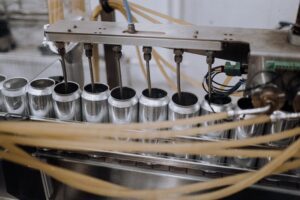The food industry plays a key role in providing consumers with safe and high-quality food products around the world. One of the most important elements in food production is quality control, which ensures that products meet certain standards and comply with regulations. However, today’s technological innovations are bringing new opportunities in the field of quality control, leading to more precise, efficient and advanced methods for evaluating food products.
Vision technologies and image analysis
One of the most important innovations in quality control is the use of vision technology and image analysis. Advanced cameras and software can accurately analyze the appearance and characteristics of food products. This can include identifying defects, such as cracks, discoloration or other defects that can affect product quality. For example, in fruit and vegetable production, cameras can automatically reject fruit with visible defects, significantly speeding up the sorting process and ensuring that only products of the right quality are delivered to consumers.
Near-infrared (NIR) spectroscopy
Another innovative quality control method is Near Infrared Spectroscopy (NIR). This technology allows chemical analysis of food products without destroying the sample. With NIR radiation, chemical components, fat, protein, moisture content and other parameters of food products can be determined in real time. NIR is used in the analysis of cereal grains, flour, oil, but also in quality control of milk or meat. This not only reduces analysis time, but also reduces waste and allows better adjustment of the production process.
Raman spectroscopy
A more specific method is Raman spectroscopy, through which we are also able to non-invasively retrieve information about the content of substances in products. Spectrally is vigorously developing a solution using precisely Raman spectroscopy in the field of quality control in the food industry. What does the whole process consist of? Non-invasive laser radiation is used for measurements, so measurements are fast, require no sample preparation, and, above all, non-destructive. Measurements can be taken both through partially transparent packaging and at any stage of production, including the finished product.
Read more about the Spectrally device[here].
Microbiological rapid detection tests
Food safety is a key aspect of quality control, especially when it comes to the presence of microbial pathogens. Traditional culture methods can be time-consuming, so rapid microbial detection tests are being developed. Modern tests based on molecular technologies, such as PCR (Polymerase Chain Reaction), allow instant identification of pathogenic microorganisms, which allows for rapid response and isolation of the contaminated batch of products.
Data integration and Big Data analysis
In today’s food industry, data collection and analysis play a key role in quality control. Information systems allow tracking each batch of products from the time the raw materials are delivered to the consumer. Big Data analysis makes it possible to detect trends, identify sources of problems in production and improve the entire process. This allows you to respond quickly to any quality problems and ensure that your products meet consumer expectations.
In general, quality control is indispensable in the food industry to ensure the safety, quality and regulatory compliance of food products and to satisfy consumer expectations. It acts as a safeguard against various hazards that can occur in the food production process.
Quality control in the food industry is constantly evolving with new technologies and innovative approaches. Vision technologies, NIR spectroscopy, microbiological testing and Big Data analysis allow for even better consumer protection, improved product quality and more efficient production. As these technologies become more accessible and affordable, we can expect quality control in the food industry to become more sophisticated and precise. This will allow us to enjoy even safer and tastier food.

